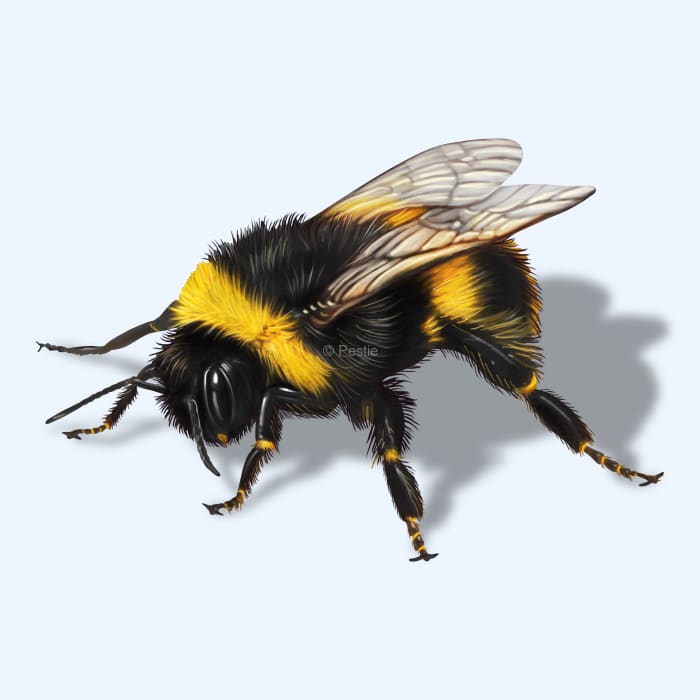How to identify and treat bumblebees

What’s the buzz with these fuzzy pests?
Finding large insects buzzing around your yard can often be a little alarming, especially if you get too close to a certain spot and they start whacking and dive-bombing into you!
If you’ve stumbled into a bumblebee nest, you might not count yourself so lucky, but they are actually a rare find. You may also feel a bit conflicted; we know they are important pollinators, but you don’t want them stinging your family, pets, or houseguests either.
While bumblebees can be an inconvenience sometimes, there are a few ways you can manage them to keep everyone safe.
How to identify bumblebees
Bumblebees are large and fuzzy insects that can be seen flying from flower to flower throughout the spring and summer months. Their bodies are relatively round and are completely covered in hairs.
They have that classic bee coloration of yellow and black, although some bumblebee species can have some orange and red on their bodies as well. This coloration serves as a warning to predators and us that these insects come with a sting!
They also have two pairs of wings that are relatively small compared to their large body size. Even so, they are very good fliers.
How big are bumblebees?
Bumblebees are larger than most bees and range between ½ to 1 inch in length. The queen will be much larger than the worker bees and the males.
What other bees look like a bumblebee?
Carpenter bees are often confused with bumblebees due to their size and coloring similarities. However, a bumblebee is fuzzy all over its body, including the hind part of the abdomen, while a carpenter bee is smooth on its abdomen.
Additionally, bumblebees don’t chew or eat wood, whereas carpenter bees will create holes in wooden structures.
Lastly, bumblebees live in colonies with a queen, and carpenter bees are solitary bees.
How to get rid of bumblebees in your yard
Finding a bumblebee nest in your yard, under your deck, or tucked away in an inconvenient spot, can be difficult to deal with. For the most part, leaving it alone is often the best solution. Bumblebee nests aren’t reused after the winter, so, if you can redirect walking routes or keep people and pets away from the area, the problem will go away on its own.
You could also fence over the nesting area by putting chicken wire and stakes around it to keep anyone from stumbling over the nest and getting stung. It’s best to do this at night to minimize disturbing the nest.
If the nest must go, then you should consult with a professional to try and relocate the nest to another location.
Preventing bumblebees from nesting in your yard can be the best solution. You can do this by plugging up any rodent holes you find, sealing up holes in the ground, trees, or side of the home, and planting eucalyptus and mint plants in your garden.
Where do bumblebees live?
Bumblebees can be found throughout the United States and can tolerate cooler temperatures than their honeybee cousins.
A founding queen will create a nest in an abandoned burrow or some sort of existing chamber or opening in the spring in or near the ground. They don’t dig or burrow into wood. An old rodent’s nest, mulch or compost pile, and even birdhouses have been used by queens to establish their colonies.
Colonies can grow to 50-400 members throughout the warm seasons.
Treat bumblebees with Pestie
If you're still having trouble keeping bumblebees away, the best option is to use a pro-grade, effective pest control solution like Pestie.
Pestie is a do-it-yourself pest control solution that's specially designed to keep bumblebees and other pests away from your home.
With Pestie, you can rest easy knowing that your living space is protected and free of creepy crawlies. And the best part? It's designed for people, pets, and the planet, so you can say goodbye to harsh chemicals and hello to peace of mind!
- Save hundreds compared to traditional annual pest plans
- People, pet, and planet-friendly
- Pro-grade customized formulas
Quick facts
How dangerous are Bumblebees?
Medium danger risk
Although they might seem intimidating, bumblebees are not as aggressive as honeybees. They won’t swarm in large groups, and they won’t sting unless attacked.
If you are allergic to bee stings, then it’s best to approach bumblebees with caution or avoid them entirely. Unlike honey bee stingers that detach from the bee, bumblebee stingers aren’t barbed and can sting you multiple times.
Males can sometimes swarm in large groups when mating and will dive at a passerby to defend their territory, but males can’t sting as they don’t have a stinger!
- Scientific name
Bombus spp
- Other common names
Humblebees
- Colors
Yellow and black, sometimes with red and orange markings Diet: nectar and pollen
- Life span
1 year
- Diet
Nectar and pollen
While honeybees stop pollinating and foraging at around 65°F, bumblebees have been observed foraging even below 50°F!








